Paramount is going to release what will be the 13th ever Friday the 13th film next year. So, we’ve been looking back at the prior Friday films in search of trivia and answers to long simmering questions: Friday the 13th, Part 2, Part 3, The Final Chapter, A New Beginning, Jason Lives, New Blood, and Jason Takes Manhattan. Now, it’s time for Jason Goes to Hell: The Final Friday (1993):
[My sources from this point forward are: Crystal Lake Memories: The Complete History of Friday the 13th documentary & the companion coffee table book of the same name]
1. It was supposed to be Freddy Vs. Jason
Sean Cunningham made this:

In 1980, it grossed the equivalent of $123 million if sold at 2014 ticket prices
Nearly a decade later, he made this:
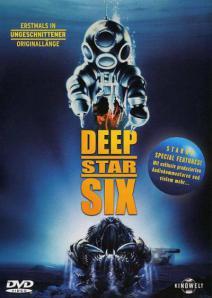
In 1989, it grossed a rather horrible $8 million, $17 million at current ticket prices
The guy had fallen on hard times, financially. So, even though he didn’t really like horror films he was desperate to get back into the Friday the 13th business, working with Michael De Luca at New Line to buy back the film rights from Phil Scuderi and the other Boston-based theater owners who’d owned the franchise since 1980. So, with Jason now set up at the House that Freddy built surely this wouldn’t be far behind:

But then Cunningham’s old buddy Wes Craven, also in need of a career boost, decided he wanted to do this:
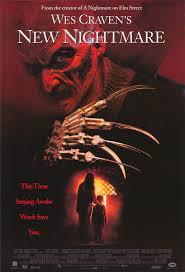
Sure, the Nightmare on Elm Street franchise had bottomed out in 1991 with Freddy’s Dead, but the return of Wes Craven behind the helm was enough to trump any potential Freddy Vs. Jason team-up. Plus, even before Craven claimed his territory they still couldn’t quite figure out a story to bring Freddy and Jason together, and New Line wasn’t convinced they could deliver something to meet fan’s expectations. So, rather than do nothing Cunningham decided to make one last return for Jason, making sure to end on this teasing note:
Yes, that’s Kane Hodder’s hand, not Robert Englund’s, wearing the Freddy glove.
2. The director was young, fresh out of film school, and had actually once visited the set of the first Friday the 13th film when he was a kid
This is Jason Goes to Hell director Adam Marcus on set:
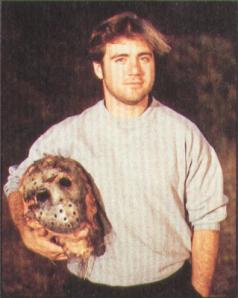
Get ready to feel inadequate: he was only 23 when he directed that movie. How did that happen? Well, he grew up friends with Sean Cunningham’s son, Noel, even getting invited to the set of the first Friday the 13th to help fetch Sean coffee (like a very, very young PA). Over a decade later in 1991, Sean hired Adam straight out of NYU Film School. Adam brought with him a script written by a NYU friend Dean Lorey, and Sean wanted to produce it for them. It ended up at Disney, where it turned into My Boyfriend’s Back (1993). However, Disney wouldn’t let a first-timer like Adam direct it. So, he clearly needed his first feature film credit. Since Sean only wanted to produce, not direct, a new Friday the 13th he gave Adam his first big break. As you’ll see later in the list, it did not go well. Adam wouldn’t get to direct another film until Let it Snow in 1999, and the entirely forgotten Val Kilmer crapfest Conspiracy in 2008. As of late, he’s moved more toward writing, having co-written last year’s Texas Chainsaw 3D.
3. Where did the idea for the body-hopping Jason come from?
Adam Marcus’ original story treatment completely ignored Jason Takes Manhattan but did pick up where Part VII: The New Blood left off, i.e., Jason neutralized and trapped at the bottom of Crystal Lake. A mystery man would dredge Jason’s body back up, and drag it to a cabin converted into a science lab. There, he would begin an autopsy, setting us up to expect Jason to wake up and go apeshit. Well, Jason wakes up only to watch his own black heart torn out by the the mystery man, the removal of the heart instantly draining Jason of any sign of life. Then, the man, who would turn out to be Jason’s heretofore unseen/unmentioned brother Elias, would consume the heart, thereby absorbing Jason’s powers.
They ultimately dropped every single part of that other than the notion of Jason’s essence being transferable from one body to another.
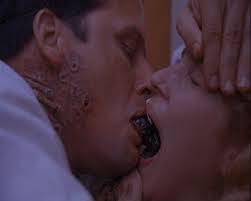
In practice, by having Jason body-hopping from one victim to another via ingestible parasite in search of a way to be reborn they seem to have copied The Hidden (1987), a little known science fiction flick from New Line’s archive.
4. The script was written in 4 days. Kind of.
If I were to tell you that Jason Goes to Hell was written in a mere 4 days your response should probably be, “Yeah, that makes sense. I’d buy that. The film makes about as much sense as something written in 4 days would.” Here’s what happened:
Jay Huguely, then known for his writing contributions to Magnum P.I., was hired to draft the Jason Goes to Hell screenplay. However, what he delivered was 10 kinds of awful, and at that point they were up against a deadline. New Line needed to see a script, as in like yesterday. So, Sean Cunningham, who was also producing My Boyfriend’s Back at the time, turned to that film’s writer, Dean Lorey, to completely re-write Huguely’s script. Cunningham essentially locked himself in a room with Lorey for 4 days, and wouldn’t let him leave until the screenplay was finished. Later on, Deepstar Six writer Lewis Abernathy was brought in for uncredited work on the opening sequence:
Nightmare on Elm Street 5 writer Leslie Bohem did a last-minute polish on the whole thing over a weekend. Bohem was well on his way to being the guy who wrote Daylight (1996) and Dante’s Peak (1997), and didn’t want his name attached to Jason Goes to Hell. So, in the closing credits he’s listed as the Executive Typist.
5. It used the same casting director as the first Friday the 13th, who only agreed to do it so he could return to Los Angeles to be near his dying mother
East Coast-based casting director Barry Moss had cast the first Friday the 13th, but had nothing to do with the franchise past that point. By 1992, his mother, who lived in Los Angeles, was dying from cancer. Knowing this, Sean Cunningham offered Moss a professional reason to return to LA: work as casting director for Jason Goes to Hell, and stay at your old home with your dying mother in your off-time. That’s the only reason Moss returned to the franchise after such a lengthy absence.
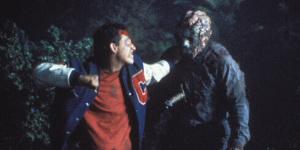
John D. LeMay beating on Jason
Moss was crucial in recruiting the first Friday the 13th cast to not include a single teenager character (at least in the original script). They would cast people with recognizable prior credits Erin Gray (Buck Rogers, Silver Spoons), Steven Williams (21 Jump Street), Allison Smith (Kate & Allie), and, of course, John D. LeMay (the only actor to appear in both the Friday the 13th TV series and a Friday the 13th film as separate characters).
6. Steven Williams would only play bounty hunter Creighton Duke if he could dress as a cowboy.
This is Steven Williams as Creighton Duke, a part Tony “Candyman” Todd also auditioned for:
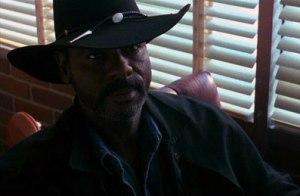
Am I the only one getting a Walker, Texas Ranger vibe?
The character was created as an homage to George Romero’s habit of making African American actors his film’s heroes. Plus, they wanted to give Jason a worthy adversary, reasoning he’d only had ever had one of those (i.e., telekinetic Tina from New Blood). But why dress him like a modern-day cowboy? Well, that was all Williams’ doing. When he read the script he decided the character absolutely had to wear a cowboy hat and boots along with a long outback coat. He wouldn’t be in the film if they dressed the character any differently. That’s at all how they pictured it, but you try saying no to Mr. X from The X-Files.
7. The screenwriter, Kane Hodder, and even 2 random California DJs have cameos
The assistant coroner who jokes about having taken a mango-sized crap on Jason’s mask?

That’s screenwriter, Dean Lorey, who so nervous he couldn’t remember his lines and just adlibbed everything.
The security guard who refers to Jason as “nothing but a big old pussy”?
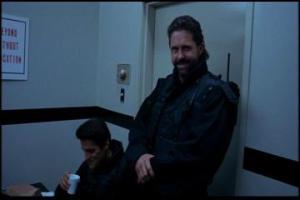
That’s Kane Hodder, aka, the guy who played Jason
The police officers who die horribly?

That’s Los Angeles radio DJs Mark Thompson and Brian Phelps. They used their radio show to beg for parts in the film. Marcus heard it on the radio, and called them to promise to write them not just parts but gruesome deaths.
8. What was with all the male nudity?
Nightmare on Elm Street has their gay entry (Nightmare on Elm Street 2). The closest Friday the 13th has ever come to that level of homoerotic subtext is probably Jason Goes to Hell‘s shaving scene in which a man shaves another man as precursor to inserting his parasite in his throat.
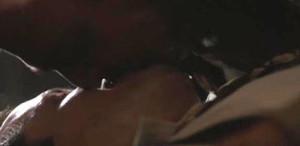
Beyond that, there’s simply quite a bit more male nudity than your typical Friday the 13th. That last part is because Adam Marcus and Dean Lorey actively rejected the Puritanical Friday the 13th formula whereby those who did drugs and/or had sex were punished with brutal death. In fact, the sex scene with the campers was only added in re-shoots after test screening audiences wanted to see more of your standard Friday the 13th scenarios. Marcus chafed at being forced to do that. So, he decided to have the guy and the girl pretty much equally nude, and that was the general rule with nudity for the entire film: the only way to make it acceptable was to show just as much man-boob as female-boob, so to speak.
9. Kari Keegan walked off the set, and only returned when Adam Marcus was removed and Sean Cunningham inserted as the director of the final days of filming
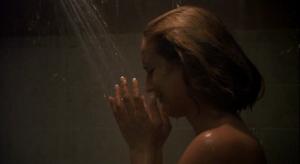
Kari Keegan’s character crying in the shower
Adam Marcus wanted Keegan to do it completely nude, ala Glenn Close sitting in a shower naked and crying in The Big Chill. Keegan says she told them from the get-go she wouldn’t do nudity while Marcus maintains she was never upfront with him about that. Keegan counters that Marcus knew, but kept telling Cunningham he’d be able to convince her to change her mind. She never did, and during the scene she wore a flesh-colored bathing suit bottom and Madonna-like cone bra just with dixie cups instead of cones. The water so hot, though, that she was literally crying from pain.
Keegan complained about the whole thing to her agent, who then really let everyone on the production have it, particularly Adam Marcus. As a result, Keegan and Marcus briefly became enemies. It got so bad she walked off the set, even though they were mere days away from wrapping. So, Cunningham had to take the movie away from Marcus, and come in to direct the final couple of days of filming. That’s the only way they could get Keegan back.
10. It was originally filmed at 22 frames per secod
From all of his years of directing and producing, Sean Cunningham concluded that actors never took their cues fast enough, meaning it would take them just a couple of seconds too long to (for example) go out of a room through a door. Instead of trying to just direct the actors to go faster, he decided the best option was to alter the way the film was actually shot. The standard would be to shoot at 24 frames per second, but he thought if you filmed at 22 frames per second then you wouldn’t be able to detect any slight hesitation on the part of the actors. You could align the audio with the footage using a harmonizer, which Cunningham did when he tried out this 22 frames method with Deepstar Six. Adam Marcus was forced to film Jason Goes to Hell that way as well. However, an unexpected though obvious consequence of filming everything at a slightly faster frame rate was that (for example) where they thought they had a 90 minute film they only actually had 80 minutes.
11. Almost half of the film came from re-shoots
According to editor David Handman, nobody viewed any dailies while filming as you normally would. Handman was cutting together all of the footage through the initial 28-day shoot, but because Adam Marcus was so inexperienced and their budget so low no one cared to actually view any of the footage until they had finished filming. Once they saw the footage they realized it was a total disaster. By Cunningham’s estimation, they were only able to salvage around 45-50 minutes of Marcus’ original work, in large part because he had filmed an 8-minute slow-motion scene (the diner massacre) as well as conversations which seemed to go on forever.
Well, the actual finished, R-rated version of Jason Goes to Hell runs 88 minutes long. So, where did the additional 38-43 minutes of footage come from? Re-shoots. During this process, some story lines were completely dropped, such as Erin Gray’s character and the sheriff being engaged and planning their honeymoon, while others were added via creative editing, such as Kari Keegan and Steven Culp’s characters being a couple. They also compressed some vital scenes. Originally, the rules on how to kill imparted by Creighton Duke were sprinkled throughout the entire film. In re-shoots, they had it all take place in one scene.
12. Erin Gray felt violated the first time she saw the film
Why would Erin Gray feel violated? Because she had no idea this happened to her character:
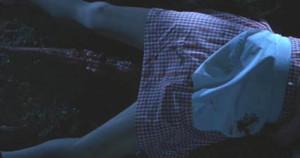
That’s the Jason Worm entering the corpse of Gray’s character via her vagina
That was never in the script, and Gray did not pose for that scene specifically. She didn’t find out until she attended the world premiere, and it left her feeling violated.
So, what happened? According to Adam Marcus, “That was a corporate decision to make the story elements kind of link up easier. I admit it’s a little distasteful, and I regret that shot, even though, trust me, audiences love it.”
13. Yes, that was the Necronomicon from Evil Dead
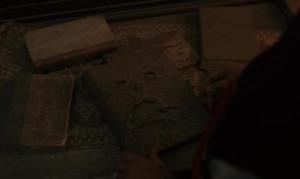
They say there was no more significance to this than them simply recycling movie props, but, yes, that is the exact same prop version of the Necronomicon created by Tom Sullivan and featured in Sam Raimi’s Evil Dead and Evil Dead 2. Apparently, Sullivan did not authorize the use of the prop, and was not paid. However, with the Evil Dead connection made this would feed into years of efforts to create a Ash Vs. Freddy Vs. Jason film, which ultimately paid off as a graphic novel.
BONUS. Not even Steven Williams understood all of Duke’s dialogue
Steven Williams got his way on the costume, but that doesn’t mean he completely understood the script:
“To this day, I don’t quite understand some of those lines in Jason Goes to Hell. I wanted to give Creighton Duke some dimensions, because the man was a little bit whacky. What was that one about the pink hot dog thing and the doughnut? I just figured this Creighton Duke guy was crazy. So you give it ambiguity. You say something, get a crazed look in your eyes, and just let the audience try to figure out what the hell is going on.”
The final damage for Jason Lives?
- Body Count: 24
- Box Office: Released on August 13th 1993, Jason Goes to Hell: The Final Friday debuted behind Harrison Ford’s The Fugitive, but finished with a gross of $15.9 million, an improvement over Jason Takes Manhattan‘s $14.3 million in 1989. This made it the second lowest-grossing Friday the 13th to that point, although $15.9 million was enough to be the highest-grossing horror film of 1993. Side note: the horror genre seriously sucked in 1993. New Line made their real money from it on home video, where as the first Friday the 13th to release an unrated version to VSH and Laserdsic it sold extremely well.
Next Friday, we’ll explain that David Cronenberg cameo in Jaxon X.
I’ll let Sean Cunningham have the last word on Jason Goes to Hell:
“New Line left me completely alone on Jason Goes to Hell, and they were completely happy-they made a bunch of money so they had no complaints. And what did anyone expect? It’s part 9 of Friday the 13th! For me, it is way past an embarrassment. The body-morphing plot-it was a dismal idea. I suspected that early on, but the finished film completely proved it. I made many, many mistakes. Adam came to me and said, ‘The last thing the fans want is to see Jason going through Camp Crystal Lake chopping up teenagers again.’ Of course, it was the only thing they wanted to see, and Adam delivered this movie that was so not good.”

